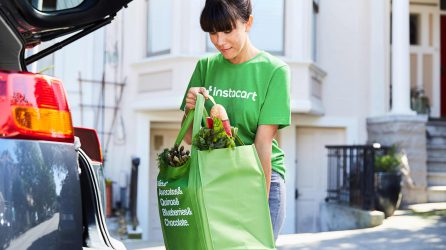Can Walmart beat Amazon and Instacart to win the battle for eGrocery?

Presented by:
Stephanie Rubin — 2021
It’s hard to think of a busier time for eGrocery than the past 12 months, and few retailers have been busier than Walmart.
We’ve had news of more local fulfillment centers, more automation in the supply chain, large-scale technology and omnichannel tests, new checkout experiences, new drone delivery tests, the scrapping of the $35 minimum order requirement for its Express delivery service, and of course that Instacart partnership.
With so much going on, it’s easy to lose sight of the bigger, strategic picture. So, what does this buzz of activity tell us about Walmart’s underlying eGrocery strategy? And where does its approach leave it vis-à-vis competitors such as Amazon and Instacart?
The coronavirus pandemic delivered a huge shock to the system for retailers. As consumers looked for safe, convenient ways to shop, eGrocery adoption stepped forward by five to 10 years. By 2025, 21.5% of US grocery sales, worth $250 billion, are now expected to come via the online channel. That’s 60% more than had been forecast before the pandemic.
In responding to this acceleration in demand, Walmart has been guided by one main objective: to reach absolutely everyone in the United States.

Walmart is finding new ways to reach shoppers
Over recent weeks and months, it has continually tested new ways to reach more shoppers and tried out new fulfillment strategies. In the process, it’s become more agile, more daring, and more willing to experiment.
Nowhere is this more apparent than in its partnership with Instacart. After years of not wanting to partner, Walmart bit the bullet last August and teamed up with the last-mile specialist to offer same-day delivery on grocery items in four US markets.
It’s a smart move for several reasons. Foot traffic in stores is down in the wake of the pandemic, so the pressure is on for retailers to figure out how to reach more people through eCommerce. Partnering with Instacart allows Walmart to respond to booming demand for online grocery right now, while keeping its options open for the longer term.
Crucially, the customer experience is right on the money. The assortment is broad, delivery is fast and reliable, and highly competitive prices mean shoppers are still getting the quintessential Walmart experience.
The partnership also plays into another strategic priority for Walmart: Walmart Plus, its fledgling membership and delivery subscription program. Designed to be a competitor to Amazon Prime, Walmart Plus has the potential to transform Walmart’s eCommerce business.
To make good on this promise, however, Walmart will need to match Amazon on delivery speed. It has made lots of progress in this area already – it is now offering two-day delivery on many items and next-day on some – and providing same-day delivery via Instacart would boost its delivery capabilities even further.

How stores give Walmart an edge
Innovative last-mile partnerships are just one way Walmart is looking to maximize its reach. It is also laser-focused on leveraging its biggest asset: its unrivalled network of stores.
Roughly 90% of the US population lives within 10 miles of a Walmart store, giving Walmart a huge platform to capitalize on the growing popularity of store and curbside pickup. At the end of 2020, it had nearly 3,200 grocery pickup locations around the country – more than six times the number offered by Amazon’s Whole Foods Market.
It’s no surprise, therefore, that stores are right at the heart of the next phase of Walmart’s eGrocery plans. And those aren’t just about facilitating pickup either. It recently announced plans to scale its automated supply chain, which will see a growing number of stores act as micro fulfillment centers capable of supporting pickup as well as to-home options.
Yet despite the advantages of its store base, Walmart’s victory in eGrocery is not a foregone conclusion. Parts of the shopper experience remain clunky, and better integration across Walmart’s grocery and main shopping platforms – as announced in early 2020 – is an urgent priority.
Walmart, like all eGrocery retailers, must also stay focused on getting the basics right. To this day, one of the biggest purchase barriers for online grocery is that shoppers do not trust somebody else to pick their produce for them. This leaves retailers with little margin for error: one bruised apple, brown banana or moldy strawberry is all it takes to undermine customer confidence.
Walmart is alive to this and regularly highlights the importance of its team of 170,000 trained personal shoppers. With good reason. As retailers fight to hold on to new customers gained during the pandemic, quality and customer experience are set to become major battlegrounds in eGrocery.
Competitors are also piling on the pressure. Although Amazon has struggled in grocery in the past, more recently it’s done an impressive job of integrating Whole Foods Market into the wider Amazon ecosystem and created a great experience for grocery delivery. What’s more, plans to open up to 1,000 micro delivery hubs across the United States could help it close the gap on Walmart’s physical retail footprint.
The dynamics between Walmart and Instacart are even more interesting. In many ways, their partnership tells the story of how retailers’ priorities have shifted over the past 12 months. Pre-Covid, Walmart reportedly baulked at Instacart’s marketplace model, specifically its insistence on listing items from all partner retailers in its own app. Post-Covid, with reach and speed the top priorities, concerns about owning the shopper journey have clearly taken a backseat.
Also taking a backseat are old definitions of what it means to ‘win’ in eGrocery. With a $39 billion valuation and a share of more than half of the US online grocery market by some estimates, Instacart is a serious eGrocery player in its own right. Recent speculation about the future direction of its business model only serves to underline this.

Walmart is taking the long view on eGrocery
That Walmart is nevertheless willing to explore potential synergies suggests it knows there is more to winning than ‘beating’ everybody else. In this new normal, collaboration could be the smarter, more sustainable option.
Of course, only time will tell if this turns out to be true of the Walmart/Instacart partnership. It’s a limited trial at this stage, but it has the makings of a game changer. If Walmart feels the partnership is successful and decides to roll it out to more markets, it could expand its reach even beyond its current base.
The battle for eGrocery will no doubt continue over the coming months and years, and we won’t know the victor for some time. But if success is about strategic clarity and playing to your strengths, you wouldn’t want to bet against Walmart right now.
Like to talk to us about how you can adjust your current digital shelf strategy to maximize category growth within Walmart? Then book a free demo with our eGrocery experts today.
All the digital Shelf Analytics You Need to Succeed at Speed & Scale
See why world leading brands choose e.fundamentals for actionable digital shelf insights
Request A demoLatest Resources

CommerceIQ Launches Global Retail Ecommerce Management Platform Combining Sales, Supply Chain, Retail Media, and Digital Shelf with e.fundamentals Acquisition
Ecommerce platform enables consumer brands to grow market share profitably in today’s inflationary and supply-constrained environment through intelligent automation, supporting over 450 omnichannel retailers in 41 countries.

e.fundamentals becomes a CommerceIQ company
e.fundamentals has been acquired by CommerceIQ, the leading Retail Ecommerce Management Platform, headquartered in Palo Alto, California. Consumer brands can now harness one global software platform to power profitable market share growth across all major retailers.

5 strategic pricing opportunities CPGs should focus on now
As tensions run high between retailers and suppliers, CPGs need to be smarter than ever about strategic pricing. Here’s how to use digital shelf analytics to hold your own in tough negotiations.

What the smartest CPGs get right about selling on Instacart
This post has been updated and was originally published March 30, 2021. It's time CPGs get ready to win on Instacart. So read and learn: What's all the hype around…

5 optimization tactics to grow digital shelf sales
This post has been updated and was originally published May 14, 2020. Consumer goods companies (CPG) continue to grapple with enormous shifts to the industry as the eCommerce boom continues…

5 tactics to grow online sales for category managers
Category management has changed. We've highlighted the 5 tactics to help you scale your growth on the digital shelf at speed.
View Our Most Popular resources to help you learn and win on the digital shelf.

The Ultimate Guide to Content Management on the Digital Shelf

The Digital Shelf Cast - Listen to our latest episode





